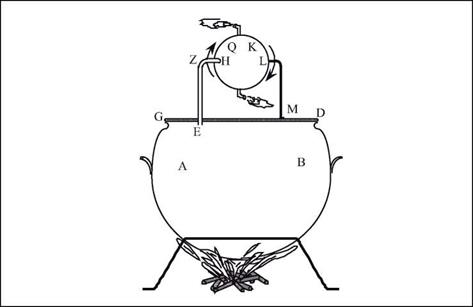The science of fluids at Alexandria under the Roman domination Heron of Alexandria and the “pneumatic” machines
The contributions of Heron of Alexandria belong for the most part to the continuum of work of Ctesibios and Philon of Byzantium. It was believed for quite some time that he lived in the 1st century BC. Now, Heron, in his work Dioptra, describes how to estimate the distance between Rome and Alexandria through observation of a lunar eclipse – an eclipse that took place in 62 AD.[198] The work of Heron therefore must be dated from the second half of the 1st century AD. The importance of this detail will appear in Chapter 6 in the context of understanding Roman treatises on aqueducts. Like Ctesibios and Philon, Heron is the author of a treatise on Pneumatics. Acknowledging his debt to earlier authors, but claiming some of his own originality, he describes a number of machines. These include the fire pump or pump of Ctesibios[199] (with a single modification compared to what is shown in Figure 5.5: the intermediate reservoir C is deleted), and automatic devices that “solicit astonishment and admiration”, and therefore are essentially toys (today we would call them “gadgets”).
The principle of these automatic devices is based on the effects of pressure in fluid. Some of them use the siphon and connected chambers, as mechanisms for the automatic filling of a vase, mixing of two liquids, etc. Other devices are powered by the effects of gaseous expansion: the most remarkable invention is surely “Heron’s steam ball” (Figure 5.14), or eolipile, a device in which water brought to a boil emits steam, the pressure of which turns a ball around an axis. This is the principle of a steam engine, nothing less! But the technology (or perhaps society?) was not up to the task of industrial exploitation of this invention. [200]
|
Figure 5.14 “Heron’s steam ball”, the principle of a steam engine. “Let the cauldron AB be placed over a flame, with water; its opening will be closed by the cover GD, through which passes the bent tube EZH, its end penetrating into the small hollow sphere QK; diametrically opposite the extremity H, one mounts the pivot LM, which rests on the cover GD. One adds to the sphere two small bent tubes, welded to the sphere, diametrically opposed to each other and bent in opposite directions; these elbows must be at right angles, and the tubes perpendicular to the line HL. The following occurs when the cauldron is heated: the steam passes into the tube EZH to go into the sphere, and it leaves by the small bent tubes in the wall, and causes the sphere to turn, like figures that dance.”38 |







Leave a reply